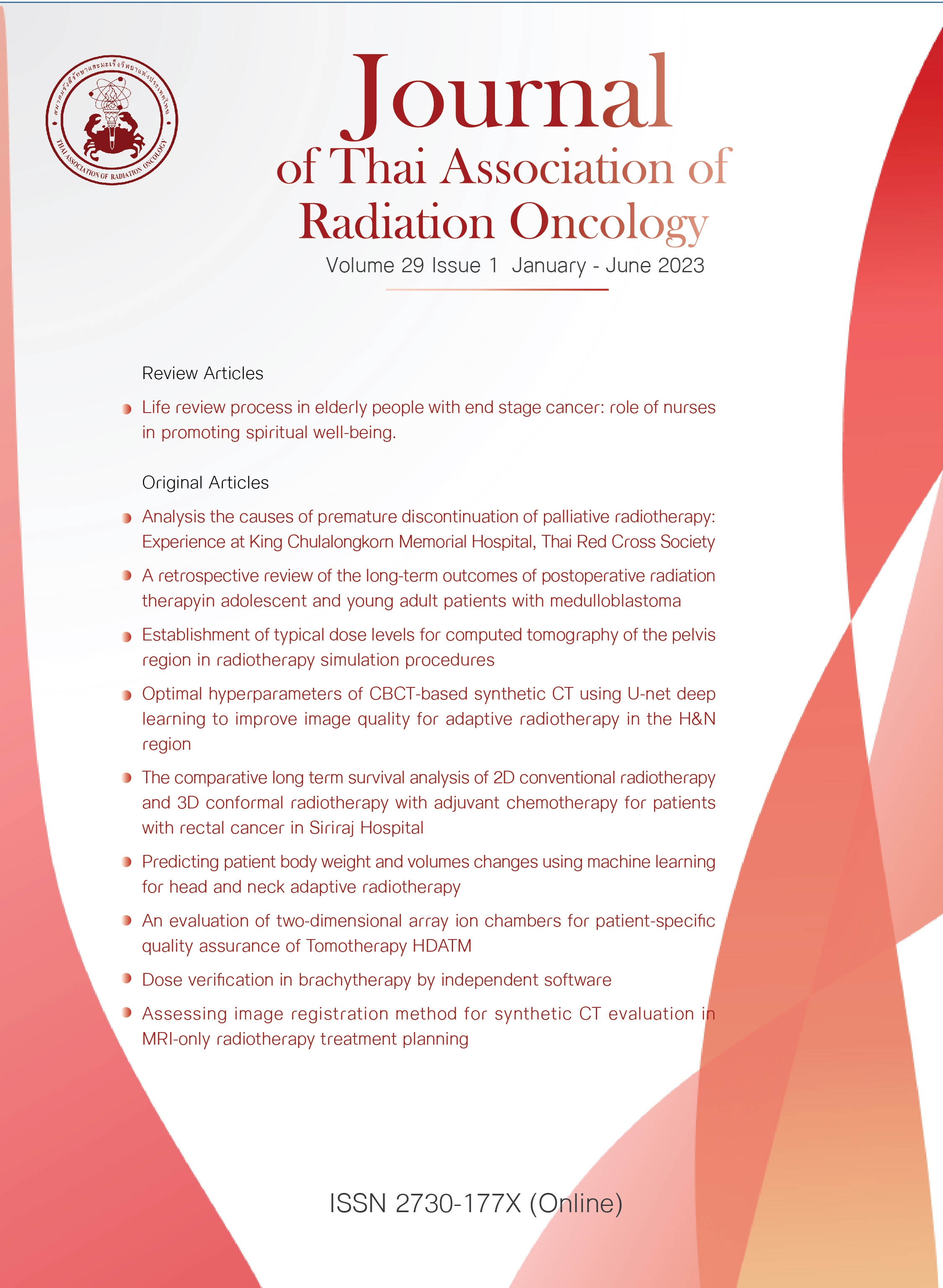A retrospective review of the long-term outcomes of postoperative radiation therapy in adolescent and young adult patients with medulloblastoma
Keywords:
Adolescent and young adult, medulloblastoma, radiation therapy, middle-income countryAbstract
Backgrounds: Medulloblastoma (MB) is a rare tumor in adolescent and young adult patients (AYA). Before 2017, there was no standard treatment for AYA with MB due to conflicting data.
Objective: The aim of this study was to evaluate the local control (LC) and overall survival (OS) of MB in AYA at our institute.
Materials and Methods: Patients 15-39 years old with MB who were sent for postoperative radiation therapy (RT) from 2007-2019 at our institute were included. Kaplan–Meier statistics were used to estimate the LC and OS.
Results: Seven patients were included. The median age at RT was 18.3 years (16.7-28.6 years). Males were more common than females, 5 males vs. 2 females. Near total resection or gross total resection was achieved in 71.4% (5 in 7 patients). Only one patient had metastatic disease (M1). The majority (71.4%) of patients were at standard risk. Six patients received RT alone. One patient received combined chemotherapy and RT. The median craniospinal irradiation (CSI) dose and total RT dose were 36 Gy (23.4-46 Gy) and 54 Gy (54-56 Gy), respectively. Local recurrence (LR) was found in one patient 4.3 years after finishing RT. Her initial treatment was subtotal resection (STR) followed by RT alone; CSI 36 Gy and posterior fossa boost to 55.8 Gy. The median clinical follow-up time and the median MRI follow-up time were 5.8 years (1.3-11.4 years) and 5.8 years (0.6-11.3 years), respectively. The median local control was 4.3 years (0.6-11.3 years) and the median overall survival was 7.7 years (1.3-11.7 years).
Conclusions: Treatment outcomes of AYA with MB from a single tertiary hospital in a middle-income country had a good LC and OS with acceptable treatment-related toxicities.
References
Smoll NR, Drummond KJ. The incidence of medulloblastomas and primitive neurectodermal tumours in adults and children. J Clin Neurosci. 2012;19:1541-4.
Albright AL, Wisoff JH, Zeltzer PM, Boyett JM, Rorke LB, Stanley P. Effects of medulloblastoma resections on outcome in children: a report from the Children's Cancer Group. Neurosurgery. 1996;38:265-71.
Lannering B, Rutkowski S, Doz F, Pizer B, Gustafsson G, Navajas A, et al. Hyperfractionated versus conventional radiotherapy followed by chemotherapy in standard-risk medulloblastoma: results from the randomized multicenter HIT-SIOP PNET 4 trial. J Clin Oncol. 2012;30:3187-93.
Packer RJ, Gajjar A, Vezina G, Rorke-Adams L, Burger PC, Robertson PL, et al. Phase III study of craniospinal radiation therapy followed by adjuvant chemotherapy for newly diagnosed average-risk medulloblastoma. J Clin Oncol. 2006;24:4202-8.
Hwang EI, Kool M, Burger PC, Capper D, Chavez L, Brabetz S, et al. Extensive Molecular and Clinical Heterogeneity in Patients With Histologically Diagnosed CNS-PNET Treated as a Single Entity: A Report From the Children's Oncology Group Randomized ACNS0332 Trial. J Clin Oncol. 2018;36:JCO2017764720.
Merchant TE, Kun LE, Krasin MJ, Wallace D, Chintagumpala MM, Woo SY, et al. Multi-institution prospective trial of reduced-dose craniospinal irradiation (23.4 Gy) followed by conformal posterior fossa (36 Gy) and primary site irradiation (55.8 Gy) and dose-intensive chemotherapy for average-risk medulloblastoma. Int J Radiat Oncol Biol Phys. 2008;70:782-7.
Sethi RV, Giantsoudi D, Raiford M, Malhi I, Niemierko A, Rapalino O, et al. Patterns of failure after proton therapy in medulloblastoma; linear energy transfer distributions and relative biological effectiveness associations for relapses. Int J Radiat Oncol Biol Phys. 2014;88:655-63.
Call JA, Naik M, Rodriguez FJ, Giannini C, Wu W, Buckner JC, et al. Long-term outcomes and role of chemotherapy in adults with newly diagnosed medulloblastoma. Am J Clin Oncol. 2014;37:1-7.
Carrie C, Lasset C, Alapetite C, Haie-Meder C, Hoffstetter S, Demaille MC, et al. Multivariate analysis of prognostic factors in adult patients with medulloblastoma. Retrospective study of 156 patients. Cancer. 1994;74:2352-60.
Brandes AA, Franceschi E, Tosoni A, Blatt V, Ermani M. Long-term results of a prospective study on the treatment of medulloblastoma in adults. Cancer. 2007;110:2035-41.
Franceschi E, Bartolotti M, Paccapelo A, Marucci G, Agati R, Volpin L, et al. Adjuvant chemotherapy in adult medulloblastoma: is it an option for average-risk patients? J Neurooncol. 2016;128:235-40.
Kann BH, Lester-Coll NH, Park HS, Yeboa DN, Kelly JR, Baehring JM, et al. Adjuvant chemotherapy and overall survival in adult medulloblastoma. Neuro Oncol. 2017;19:259-69.
Atalar B, Ozsahin M, Call J, Napieralska A, Kamer S, Villa S, et al. Treatment outcome and prognostic factors for adult patients with medulloblastoma: The Rare Cancer Network (RCN) experience. Radiother Oncol. 2018;127:96-102.
The Thai Society of Hematology. National protocol for the treatment of childhood cancers 2018.
Common Terminology Criteria for Adverse Events (CTCAE) Version 5.0 [online]. 2017 [cited 2022 Sep 16];[155 screens]. Available from: URL:https://ctep.cancer.gov/protocoldevelopment/electronic_applications/docs/CTCAE_v5_Quick_Reference_5x7.pdf
Downloads
Published
How to Cite
Issue
Section
License
Copyright (c) 2023 Thai Association of Radiation Oncology

This work is licensed under a Creative Commons Attribution-NonCommercial-NoDerivatives 4.0 International License.
บทความที่ได้รับการตีพิมพ์เป็นลิขสิทธิ์ของวารสารมะเร็งวิวัฒน์ ข้อความที่ปรากฏในบทความแต่ละเรื่องในวารสารวิชาการเล่มนี้เป็นความคิดเห็นส่วนตัวของผู้เขียนแต่ละท่านไม่เกี่ยวข้องกับ และบุคคลากรท่านอื่น ๆ ใน สมาคมฯ แต่อย่างใด ความรับผิดชอบองค์ประกอบทั้งหมดของบทความแต่ละเรื่องเป็นของผู้เขียนแต่ละท่าน หากมีความผิดพลาดใดๆ ผู้เขียนแต่ละท่านจะรับผิดชอบบทความของตนเองแต่ผู้เดียว




